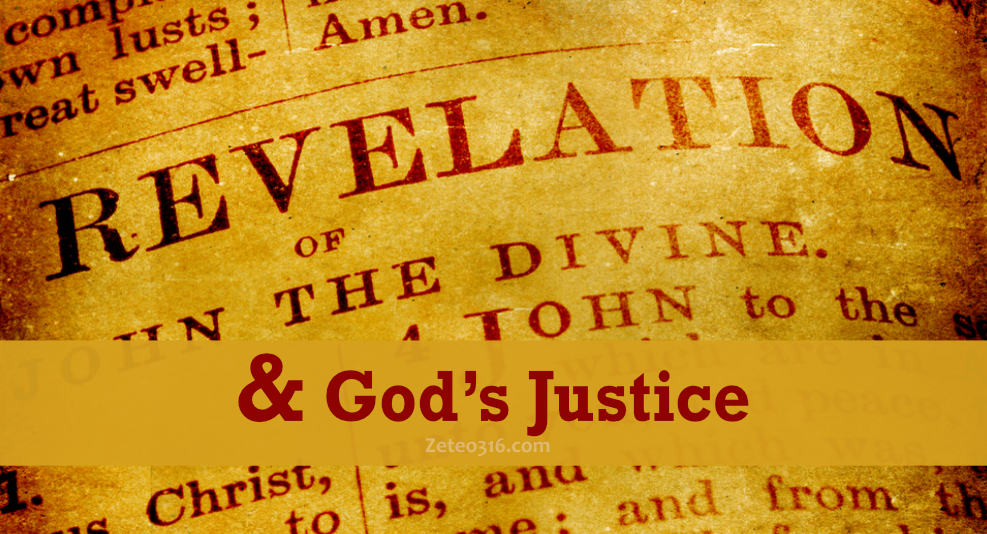
Revelation and God’s justice…the opening of Revelation’s seals are all about God’s justice. This justice includes God’s wrath. As I’ve done in the past I’m going to focus on the 4th seal, beginning with some interesting comments from our non-premil Covenant Theology friends.
In his book, Theophany – A Biblical Theology of God’s Appearing, Vern Poythress writes:
The entire sequence of judgments in [Revelation] 6:1-8:1 resides within the framework of theophany, and the actions all issue from theophany. Moreover, the specific judgments with the first four seals take place in response to orders coming from the living creatures (6:1, 3, 5, 7). The living creatures, as we have seen, reflect the character of God. The passages describe judgments from God, not merely random instances of unaccountable suffering. They reflect the anger and justice of God. In a broad sense, the visions are instances of judgment reflecting the justice of God. This justice is executed through the Lamb and the “seven spirits” (the Holy Spirit). (Page 140, Emphases mine)
According to Poythress these judgments begin with the opening of the seven seals. He adds that, from one point of view, portents of this cycle of judgment begin even before this – at Rev 4 and Rev 5 where the Lamb is introduced.
Brian Tabb takes an eclectic view of Revelation (All Things New – Revelation as Canonical Capstone). Yet he agrees with Poythress regarding God’s judgments in Rev 6:1-8:1. In the chapter “Wrath of the Lamb” under the sub-title “The Seven Seals” (pp 146-147) he writes (among other observations):
The fourth horseman, identified as ‘death’, inflicts violence by the sword, famine, pestilence and wild beasts. This recalls God’s ‘four dreadful judgments’ that God promises to bring against unfaithful Israel…
Tabb cites Ezek 14:21; Lev 26:22-26; Deut 32:22-26 and Jer 24:10. It’s also notable that he separates the judgments within the 4th seal etc from future divine justice for the 5th seal martyrs.
The 4th seal is treated variously by posttrib futurists claiming God’s wrath occurs during or after the 6th seal. Some suggest it is directed to the Jews and the church only. They see it as “Satan’s wrath” occurring under God’s “permissive will.” The 4th and 5th seals are then linked to Antichrist, and placed immediately after the Abomination of Desolation.
Some say that, even though power has been give to Death and Hades over the fourth part of the earth, it doesn’t follow that the totality of this power will be exercised. Why wouldn’t it be? Closely related is the position that authority is over a geographical section of the earth rather than its population. Of course if it’s the wrong sector the mortality rate could potentially be just as high, if not higher.
Another objection is that the death of a fourth of the world’s population at the 4th seal doesn’t mathematically gel with the Great Tribulation being the worst time in history. Christ says those days are so bad that unless they’re terminated no flesh would be saved alive (Matt 24:21-22). It isn’t a case of mortality-statistics at the time of intervention; it’s the potential of total extermination if left unchecked.
The elements of the 4th seal parallel Old Testament judgment language (see Ezek 5:1-17; 7:3-19 & Tabb’s verses above). In Ezek 7:3-19 we find references to God’s anger, fury and wrath associated with famine, sword and pestilence (v 15). These are connected to the Day of the Lord’s wrath (v 19).
Speaking of the Day of the Lord, the concept is important to systems viewing it within strictly defined parameters of their eschatology, particularly rapture timing. I’ll try to address this concept at some point in the future.
Deut 32:22-26 also speaks of famine, plague, beasts and sword. In verse 22 God says, “For a fire is kindled in My anger, and burns to the lowest part of Sheol, and consumes the earth with its yield, and sets on fire the foundations of the mountains.”
A standard response is that these OT expressions of God’s wrath were intended for Israel; hence have no relationship to a future 4th seal on a broader scale. That is a simplistic unconvincing answer.
Posttribulationists insist God’s eschatological wrath is only located in the trumpets and bowls – perhaps a carryover from historicist posttribulationism. Some stress that the aorist tense in Rev 6:17 indicates that God’s wrath is future. They reject the assertion that the missing word “church” after Revelation 3 means it has been removed before the seal judgments. However, they often use the same argument regarding the word “wrath” prior to the 6th seal.
Why would the fourth seal, sovereignly opened by Christ, contain OT wrath-judgment language if God’s wrath is absent? Can one really keep “Satan’s so-called wrath” distinct from God’s sovereign judgment on the world? For more on this see the links below.
How should this influence a futuristic premil position on God’s wrath, the church, Rev 3:10 and the rapture? Well we all bring some assumptions to prophecy. Here’s mine – if we assume an exemption for the church from God’s eschatological wrath, then perhaps it is removed at least prior to the 4th seal, whenever that occurs.
Further reading:
Tony Garland compares the horses of Revelation to Zechariah’s horses HERE
Monergism on God’s Sovereignty
Antichrist, Nations and God’s Sovereignty
God’s Sovereignty, the Antichrist etc
